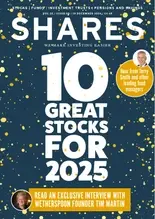
When you start investing you may hear references to so-called 'quality' companies or shares.
In some ways this description is self-explanatory. In the same way you would expect a pair of quality socks to last for a long time, a quality stock should be equally durable.
However, there are some specific attributes which distinguish quality companies from their counterparts on the market.
PRICING POWER
Pricing power (the ability of a company to increase the prices for its goods and services without unduly impacting demand - often reliant on the strength of its brand or brands)
Investment guru Warren Buffett has said: 'The single most important decision in evaluating a business is pricing power.
'If you've got the power to raise prices without losing business to a competitor, you've got a very good business. And if you have to have a prayer session before raising the price by 10%, then you've got a terrible business.'
Pricing power essentially means a company can pass on an increase in its costs to customers and still avoid being hit by a decline in sales.
This could be because it has a great brand or because it operates in a market with significant barriers to entry, enjoying technological prowess or high-level expertise.
What to look for: If a company is exposed to raw material costs, scan for evidence or commentary that it has been able to pass these on to customers in its financial results.
MARGINS
High operating margins (representing the proportion of revenues retained as profits)
Pricing power is usually represented in a company's profit margin and if a company has consistently maintained or grown its margin over time, it should be capable of generating strong profits.
What to look for: The margin is fairly easy to work out, it is essentially the company's profits divided by its revenues.
Most large firms will report their margin performance explicitly although the measure of profit by which they measure margin performance can differ.
CASH FLOW
Strong cash flow to fund the business and pay dividends
Cash is fundamental to any business as without it a company cannot pay its staff or its bills.
A firm which generates lots of cash should also be able to invest for future growth - building a new factory to sell more of its product in different markets for example - and reward its shareholders with generous dividend payments.
What to look for: In a results statement look for the 'consolidated cash flow statement' which offers a detailed breakdown of cash flows.
BALANCE SHEET
A sound balance sheet
A weak balance sheet is one with significant debt relative to the size of the company while a strong balance sheet means a firm has plenty of cash in the bank.
The latter should ensure that a firm does not go bust and has a free hand to potentially expand through acquisitions or invest in its existing business in order to achieve organic growth.
Most companies have at least some debt and a gearing ratio (the percentage of capital employed by the business that is financed by loans, in relation to that part of capital funded by equity) below 40% is probably acceptable.
If a company's gearing is above 60% investors should be looking for evidence management are seeking to reduce borrowings.
What to look for: Net cash represents the group's cash balances minus any liabilities such as debt and can be found in the section of a group's results headlined 'consolidated balance sheet'.
THE RIGHT PRICE
Even the perfect stock could be a poor investment at the wrong price. A widely used measure of value on the stock market is the price to earnings (PE) ratio.
Derived by dividing the historic or forecast earnings per share by the share price, a high ratio (of approximately 20 or higher depending on the industry it operates in) leaves little margin for error and if a company with a chunky PE even slightly disappoints the market, its shares can fall significantly.
This is the latest in a series of guides on the basics of the financial markets to appear on our website in the coming weeks.




